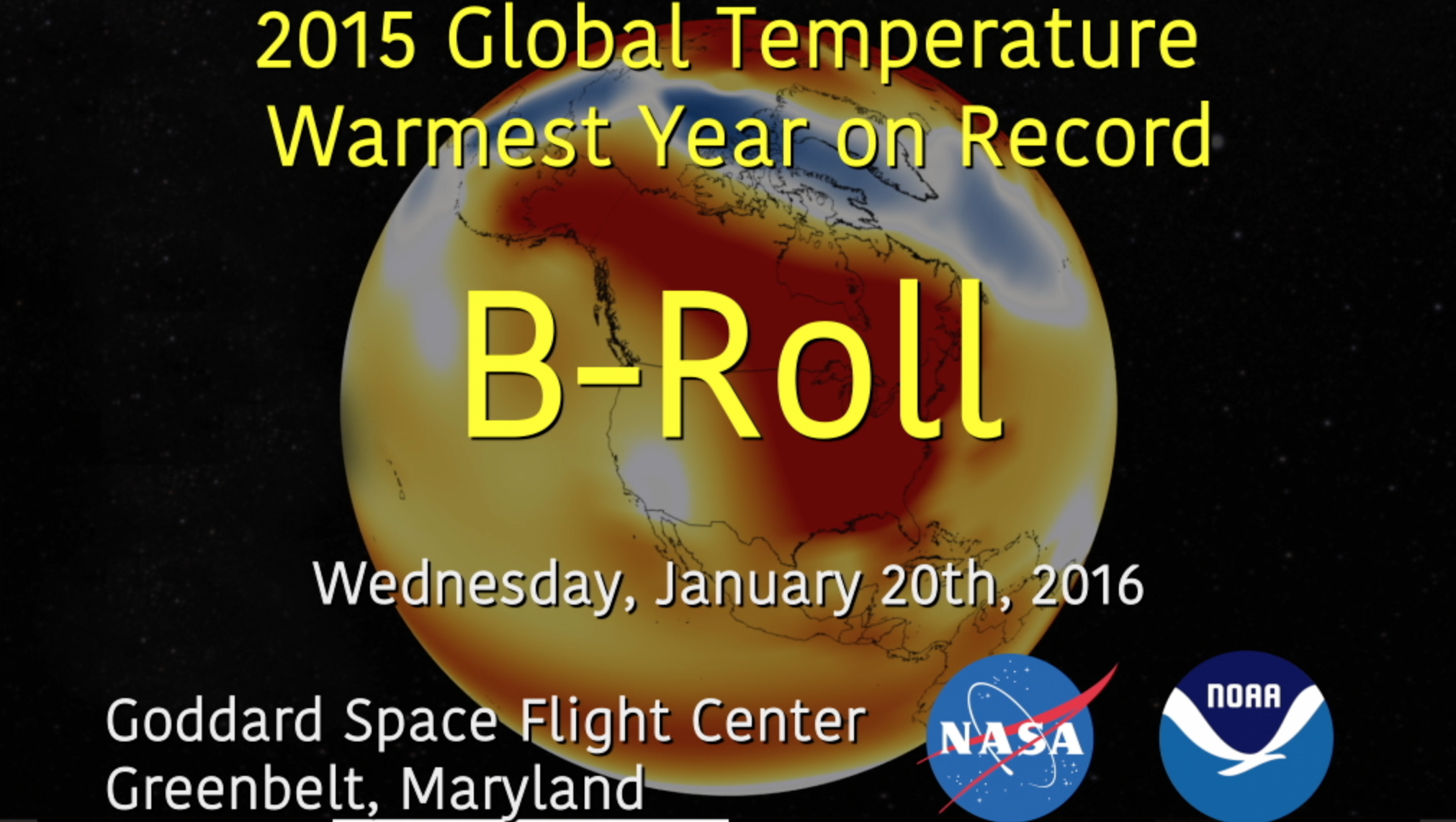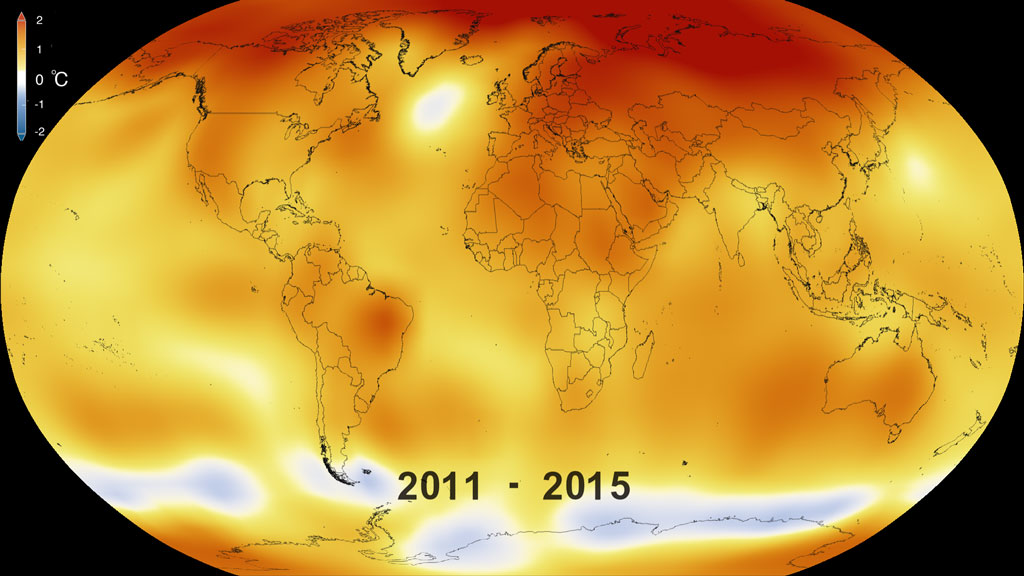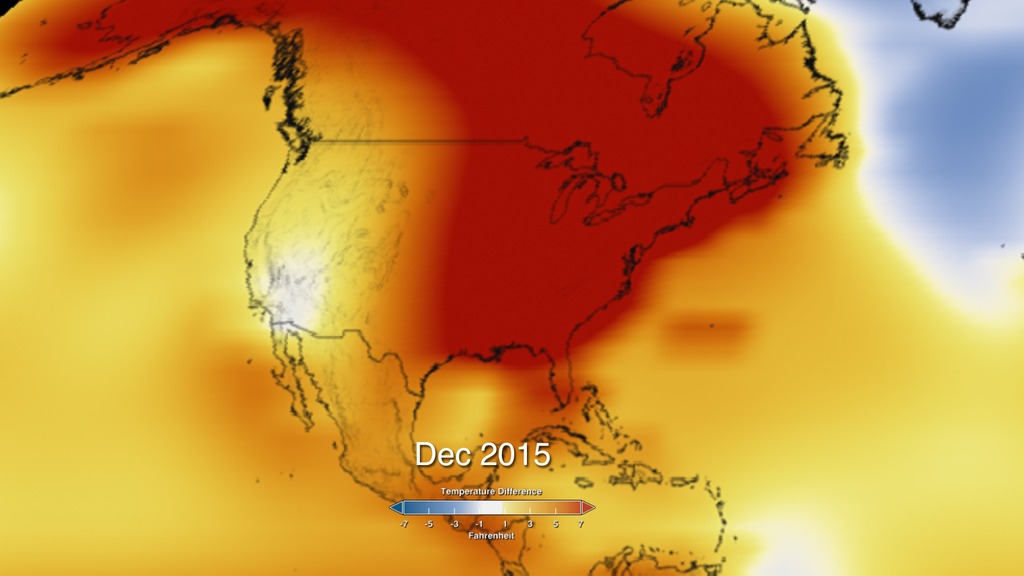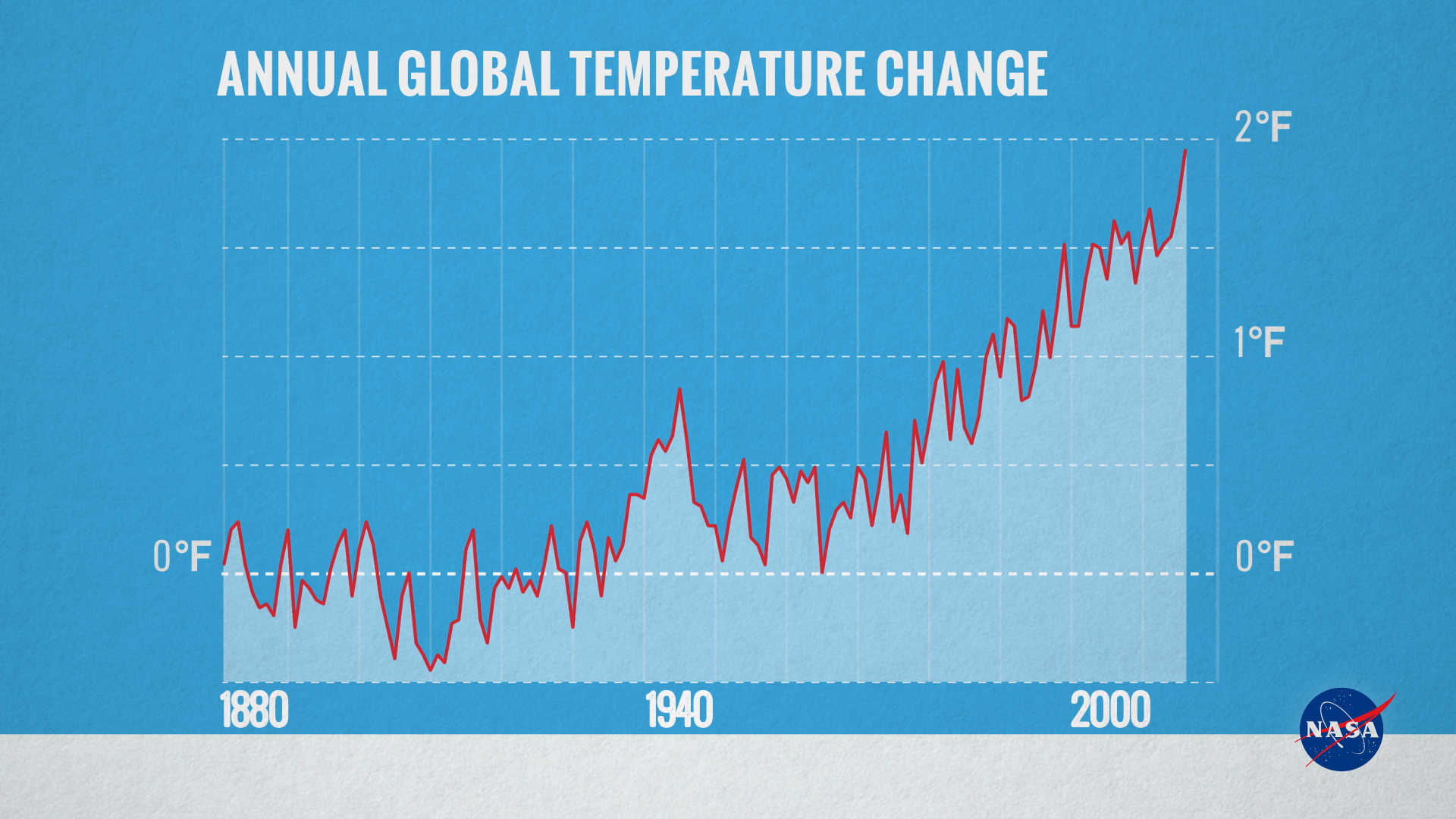2015 Global Temperature Data
Overview
Earth's 2015 surface temperatures were the warmest since modern record keeping began in 1880, continuing a long-term warming trend, according to analyses by scientists at NASA’s Goddard Institute for Space Studies (GISS) in New York (GISTEMP).
Globally-averaged temperatures in 2015 shattered the previous mark set in 2014 by 0.23 degrees Fahrenheit (0.13 Celsius). Only once before, in 1998, has the new record been greater than the old record by this much.
The planet's average surface temperature has risen about 1.8 degrees Fahrenheit (1.0 degree Celsius) since the late-19th century, a change largely driven by increased carbon dioxide and other human-made emissions into the atmosphere. Most of the warming occurred in the past 35 years, with 15 of the 16 warmest years on record occurring since 2001.
Live Shot Interviews and B-roll
NASA/NOAA 2015 Global Temperature Live Shots
Go to this pageVideo file for the release of 2015 global temperature data by NASA. Contains data visualizations, graphics, and interview clips with Gavin Schmidt, the director of the Goddard Institute for Space Studies (GISS) in New York City.Complete transcript available. || GSFC_2015WarmestYear_VF_Radcliff_appletv_print.jpg (1024x576) [135.4 KB] || GSFC_2015WarmestYear_VF_Radcliff_appletv.m4v (1280x720) [141.2 MB] || GSFC_2015WarmestYear_VF_Radcliff.webm (960x540) [108.8 MB] || GSFC_2015WarmestYear_VF_Radcliff_appletv_subtitles.m4v (1280x720) [141.3 MB] || GSFC_2015WarmestYear_VF_Radcliff_youtube_hq.mov (1280x720) [579.6 MB] || GSFC_2015WarmestYear_VF_Radcliff.en_US.srt [2.4 KB] || GSFC_2015WarmestYear_VF_Radcliff.en_US.vtt [2.4 KB] || GSFC_2015WarmestYear_VF_Radcliff.mpeg (1280x720) [1.1 GB] || GSFC_2015WarmestYear_VF_Radcliff_ipod_sm.mp4 (320x240) [76.7 MB] || GSFC_2015WarmestYear_VF_Radcliff_prores.mov (1280x720) [4.3 GB] ||
Graphics
Five-Year Global Temperature Anomalies from 1880 to 2015
Go to this pageThis color-coded map in Robinson projection displays a progression of changing global surface temperature anomalies from 1880 through 2015. Higher than normal temperatures are shown in red and lower then normal termperatures are shown in blue. The final frame represents the global temperatures 5-year averaged from 2011 through 2015. Scale in degree Celsius.This video is also available on our YouTube channel. || 4419_GISTEMP_2015_Robinson_C_print.jpg (1024x576) [107.0 KB] || 4419_GISTEMP_2015_Robinson_C_print_searchweb.png (320x180) [78.5 KB] || 4419_GISTEMP_2015_Robinson_C_print_thm.png (80x40) [7.3 KB] || celsius_composite (1920x1080) [0 Item(s)] || 4419_GISTEMP_2015_Robinson_C_youtube_hq.mov (1920x1080) [79.5 MB] || 4419_GISTEMP_2015_Robinson_C.webm (960x540) [13.3 MB] || 4419_GISTEMP_2015_Robinson_C_appletv.m4v (1280x720) [16.3 MB] || 4419_GISTEMP_2015_Robinson_C.mpeg (1280x720) [122.2 MB] || 4419_GISTEMP_2015_Robinson_C_prores.mov (1280x720) [533.7 MB] || 4419_GISTEMP_2015_Robinson_C.key [20.0 MB] || 4419_GISTEMP_2015_Robinson_C.pptx [17.4 MB] || 4419_GISTEMP_2015_Robinson_C_ipod_sm.mp4 (320x240) [4.8 MB] ||
Global Temperature Anomalies from December 2015
Go to this pageGlobal temperature data for December 2015, in degrees Fahrenheit, starting with North America and pulling back to reveal the whole world. The December 2015 temperatures are compared to a baseline of the 1951-1980 average temperature. Higher than normal temperatures are shown in red and lower then normal termperatures are shown in blue. || Dec2015Gistemp_zoomout_fahrenheit_0000_print.jpg (1024x576) [75.3 KB] || Dec2015Gistemp_zoomout_fahrenheit_0000_searchweb.png (320x180) [66.3 KB] || Dec2015Gistemp_zoomout_fahrenheit_0000_thm.png (80x40) [5.5 KB] || fahrenheit_composite_dec2015monthly (1920x1080) [0 Item(s)] || Dec2015Gistemp_zoomout_fahrenheit_0000_1080p30.mp4 (1920x1080) [3.2 MB] || 4420_GISTEMP_Dec2015_zoomout_F.webm (960x540) [2.9 MB] || 4420_GISTEMP_Dec2015_zoomout_F_appletv.m4v (1280x720) [6.5 MB] || 4420_GISTEMP_Dec2015_zoomout_F.mpeg (1280x720) [46.8 MB] || 4420_GISTEMP_Dec2015_zoomout_F_youtube_hq.mov (1920x1080) [20.1 MB] || 4420_GISTEMP_Dec2015_zoomout_F_prores.mov (1280x720) [105.0 MB] || 4420_GISTEMP_Dec2015_zoomout_F_ipod_sm.mp4 (320x240) [2.2 MB] || Dec2015Gistemp_zoomout_fahrenheit_0000_1080p30.mp4.hwshow [212 bytes] ||
Annual Global Temperature, 1880-2015
Go to this pageGraph of annual global temperatures, with respect to a baseline from the 19th century (the average of global annual temperatures from 1880-1899). In Fahrenheit. || 2015-temperature-graph-animation-v3_youtube_hq_print.jpg (1024x576) [749.5 KB] || 2015-temperature-graph-animation-v3_youtube_hq_print_searchweb.png (180x320) [87.8 KB] || 2015-temperature-graph-animation-v3_youtube_hq_print_thm.png (80x40) [7.6 KB] || 2015-temperature-graph-animation-v3_youtube_hq.mov (1920x1080) [11.1 MB] || 2015-temperature-graph-animation-v3_appletv.m4v (1280x720) [2.6 MB] || 2015-temperature-graph-animation-v3.mpeg (1280x720) [61.0 MB] || 2015-temperature-graph-animation-v3.webm (960x540) [1.5 MB] || 2015-temperature-graph-animation-v3_prores.mov (1280x720) [265.1 MB] || GSFC_20160120_Temp_m12133_Graph.en_US.vtt [64 bytes] || 2015-temperature-graph-animation-v3_ipod_sm.mp4 (320x240) [678.1 KB] ||
Multimedia Products
Gavin Schmidt on 2015's Record Global Temperature
Go to this pageGavin Schmidt, Director of the Goddard Institute for Space Studies, discusses the results of their analyses of 2015 global temperature data. Spoiler alert: it was warm. || YOUTUBE_HQ_12134_Gavin_Schmidt_2015_record_youtube_hq_print.jpg (1024x576) [92.2 KB] || YOUTUBE_HQ_12134_Gavin_Schmidt_2015_record_youtube_hq_searchweb.png (320x180) [82.4 KB] || YOUTUBE_HQ_12134_Gavin_Schmidt_2015_record_youtube_hq_thm.png (80x40) [6.0 KB] || 12134_Gavin_Schmidt_2015_record.mp4 (1920x1080) [29.2 MB] || APPLE_TV_12134_Gavin_Schmidt_2015_record_appletv.m4v (1280x720) [13.5 MB] || WEBM_12134_Gavin_Schmidt_2015_record.webm (960x540) [11.7 MB] || YOUTUBE_HQ_12134_Gavin_Schmidt_2015_record_youtube_hq.mov (1920x1080) [127.9 MB] || NASA_TV_12134_Gavin_Schmidt_2015_record.mpeg (1280x720) [98.5 MB] || PRORES_B-ROLL_12134_Gavin_Schmidt_2015_record_prores.mov (1280x720) [391.4 MB] || GSFC_20160120_Schmidt_m12134_Temp2015a.en_US.vtt [622 bytes] || NASA_PODCAST_12134_Gavin_Schmidt_2015_record_ipod_sm.mp4 (320x240) [4.8 MB] ||




